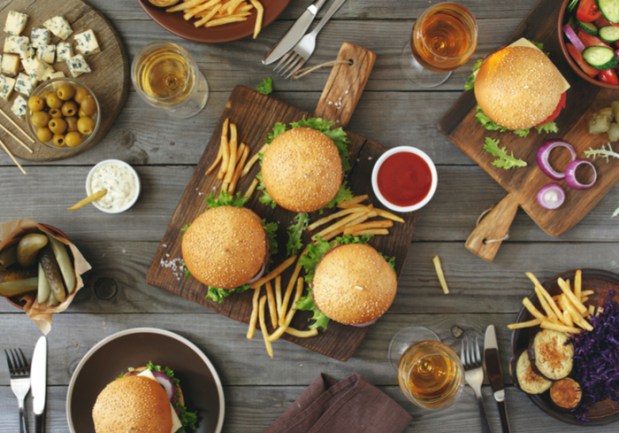How Five QSRs Are Tapping Into A Mobile Order-Ahead Future

For their mobile order-ahead offerings, some quick-service restaurants (QSRs) are choosing to team up with technology providers and other retailers, with the goal of serving consumers hungry for convenient digital options.
In one case, a QSR is providing a mobile order-ahead service to workers in a chain of co-working spaces. Fast casual restaurant Sweetgreen and office space provider WeWork are partnering to enable diners to pick up food from a WeWork location of their choice. To use the service, WeWork members can place their orders with Sweetgreen and then select a WeWork location where they will retrieve their meals.
As the fourth quarter comes to a close, the PYMNTS Mobile Order-Ahead Tracker noted that QSRs are adapting to a world of digital technology by giving customers drive-thru service and lanes dedicated to orders placed via online channels.
From Burger King to McDonald’s and Dunkin’, as well as Panera and Chipotle, QSRs are tapping into mobile order-ahead technology to serve customers looking to place their orders with their phones and tablets.
The Burger King app saw two million downloads in the first few weeks of its launch. Technology has become a major priority for the QSR chain. Earlier this year, it was reported that Restaurant Brands International, which owns Burger King, appointed its previous Chief Financial Officer Josh Kobza to head up the company’s technology efforts. Broadly speaking, the company is working to “accelerate our use of technology to enhance our guest experience,” noted Chief Executive Officer Daniel Schwartz. He said that delivery has driven sales in international markets such as Spain, China and Turkey, but the company is still in the beginning stages of testing delivery in the U.S. Schwartz said that in April, the company rolled out delivery with “several hundred” Burger King restaurants (as well as Popeyes), and that “our initial results are encouraging.”
McDonald’s plans to spend $6 billion by 2020 on digital menu boards, self-order kiosks and other updates to its U.S. stores. McDonald’s third-quarter sales, in particular, were driven by higher average checks brought by a menu pricing increase, favorable product mix shifts, delivery and self-order kiosks. And the latter technology is a big part of the strategy, as the machines are in more than 15,000 of the QSR’s restaurants around the globe. The news came a few months after it was reported in June that the chain planned to add self-service stations at a rate of 1,000 U.S. stores per quarter for the following eight to nine quarters. On a call with analysts in October, President and Chief Executive Officer Steve Easterbrook noted that the chain is seeing higher average tickets with the popularity and use of self-order kiosks, as “people dwell for longer.”
Three percent of Dunkin’ Donuts transactions are made via mobile and pay on-the-go ordering. To help facilitate those types of orders, the restaurant’s new concept store involves separate drive-thru lanes for mobile orders. The stores’ interior design also offers a separate order-ahead queuing area. The concept store also has a series of self-service kiosks, where people can order without the help of a staff member. There is also a grab-and-go section with simple, pre-packaged items like apple sauce, yogurt and beef jerky. Dunkin’ Brands Vice President of Operations, Strategy and Supply Chain Chris Fuqua said that “it’s all about making guests’ lives a little more convenient. Customers can now pull into the mobile order area, say ‘I’m here to pick up my order,’ give their first name and be on their way.”
One third — or 33 percent — of Panera orders are placed online, via mobile app or at a kiosk. And last year, digital orders made up 31 percent of the QSR’s sales, or about $1.75 billion in revenue at the time. Off-premise dining, which encompasses to-go, delivery and catering, comprised about 62 percent of Panera’s overall business. CEO Blaine Hurst noted earlier this year that digital is on the rise, and that the 31 percent of orders the company has today could grow to be a full half of orders in the near future. Some markets are already there, he said, and some have already blown past that point to reach 60 percent of orders going digital. But Hurst said the plan is not to have a delivery-only setup, and that Panera will always have physical locations.
Digital made up an 11.2 percent portion of Chipotle’s total sales in the third quarter of 2018. And Chipotle has been collaborating with third parties on digital efforts: In August, it was reported that the QSR chain was teaming up with DoorDash for delivery. The tie-up comes as Brian Niccol, the company’s chief executive, has been working on turnaround efforts such as a loyalty program, Reuters noted at the time. To tap into the offering, customers can use the restaurant’s website and mobile app. At the time, the company offered free delivery on a minimum order from over 1,800 locations. On the news of the service, the company’s shares rose slightly during trading. The news came after the chain launched a mobile app in November of last year, with the goal of enhancing the customer’s dining and online ordering experience.
Beyond QSRs, mobile order-ahead technology has spread to other sectors. Education campuses, too, are tapping into the technology to serve students and their visiting families, suggesting that the technology has implications outside of fast food drive-thrus or dining rooms.
